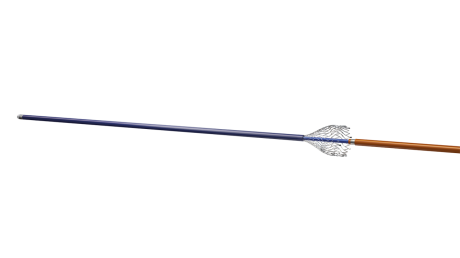INDICATIONS FOR USE:
The VICI VENOUS STENT System and VICI RDS Venous Stent System are both indicated for improving luminal diameter in the iliofemoral veins for the treatment of symptomatic venous outflow obstruction. CONTRAINDICATIONS: The VICI Venous Stent System and VICI RDS Venous Stent System are both contraindicated for use in:
• Patients who are judged to have a lesion that prevents complete inflation of a balloon dilatation catheter or proper placement of the stent or the stent delivery system.
• Patients who cannot receive intraprocedural anti-coagulation therapy.
WARNINGS:
• Safety and efficacy for stenting outside of the Common Iliac Vein (CIV), External Iliac Vein (EIV) and Common Femoral Vein (CFV) with the VICI VENOUS STENT and the VICI RDS™ Venous Stent have not been studied.
• Stenting in the region of the inguinal ligament in some patients may result in an increased risk in stent fracture.
• For compressive lesions in the CIV, the VICI VENOUS STENT and the VICI RDS Venous Stent do not need to be extended across the Inferior Vena Cava (IVC). Physicians should extend the stent up to 1.0cm beyond the compressive lesion
• The VICI VENOUS STENT System and the VICI RDS Venous Stent system have not been evaluated for contralateral access. This access approach is not recommended.
• Access: This device is designed for ipsilateral femoral or popliteal and jugular access only. Access site should allow for adequate assessment of disease and inflow.
• Sizing: To eliminate risk of stent migration or stent movement, do not deploy the VICI VENOUS STENT or VICI RDS Venous Stent unless the target diameter has been properly measured. Improper stent size selection can lead to stent migration or inadvertent stent movement.
• The diameter of the stent should be 1mm - 2mm greater than (“over”) the measured diameter of the surrounding “normal” vein.
• In postthrombotic diseased veins, target veins should be pre-dilated to the reference vein diameter.
• In non-thrombotic lesions, size stent diameter to ensure stent engagement in area of central focal compressive lesion (e.g. vessel crossing) and adequate wall apposition in peripheral normal veins.
• Dilated veins peripheral to stenosis are not normal veins, and therefore should not be used to measure reference vein diameter and stent diameter selection.
• Excessive oversizing of stents has been reported to contribute to post-operative patient pain.
• The stented length should be at least 1cm longer than the obstructive venous lesion (a minimum of 0.5cm centrally and 0.5cm peripherally).
• Stent Deployment: The VICI VENOUS STENT and the VICI RDS™ Venous Stent cannot be recaptured into the delivery system once it is partially deployed. Attempted recapture may result in damage to the vein. • Careful attention should be used to avoid stretching or compressing the stent during deployment, as this may increase risk of stent fracture. During deployment, maintain the position of the Inner Shaft Hub.
• Allergy Information: The VICI VENOUS STENT and the VICI RDS VENOUS STENT are constructed of a nickel-titanium alloy (Nitinol) and tantalum, which are generally considered safe; however, patients who are allergic to these materials or who have a history of metal allergies may have an allergic reaction to this device.
PRECAUTIONS:
• Sizing: The minimally acceptable sheath French size is printed on the package label. Do not attempt to pass the stent delivery system through a smaller size introducer sheath than indicated on the label.
• Thrombus: If thrombus is noted once the stent is expanded, thrombolysis and/or PTA should be considered.
• Procedural Complications: In the event of procedural complications such as infection, pseudoaneurysms, or fistula formation, surgical removal of the stent may be required. MAGNETIC RESONANCE IMAGING (MRI) MRI Safety Information
• Non-clinical testing has demonstrated that the VICI VENOUS STENT System and the VICI RDS™ VENOUS STENT System are Magnetic Resonance (MR) Conditional.
• A patient with the VICI VENOUS STENT or VICI RDS VENOUS STENT can be scanned safely, immediately after placement, in an MR system meeting the following conditions:
• Static magnetic field of 1.5 T or 3.0 T only.
• Maximum spatial gradient magnetic field of 4,000gauss/cm (40T/m).
• Maximum MR system reported, whole body averaged specific absorption rate (SAR) of 2W/kg (Normal Operating Mode).
• Under the scan conditions defined, the VICI VENOUS STENT and VICI RDS VENOUS STENT are expected to produce a maximum temperature rise of 6°C after 15 minutes of continuous scanning.
• In non-clinical testing, the image artifact caused by the VICI VENOUS STENT and VICI RDS VENOUS STENT extend approximately 5mm from this device when imaged with a gradient echo pulse sequence and a 3.0 T MR system. The lumen of the VICI VENOUS STENT or VICI RDS VENOUS STENT cannot be visualized on the gradient echo or T1- weighted, spin echo pulse sequences


